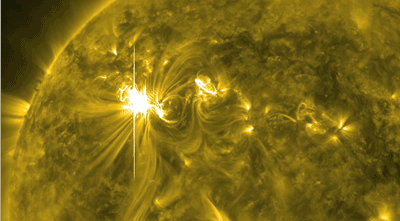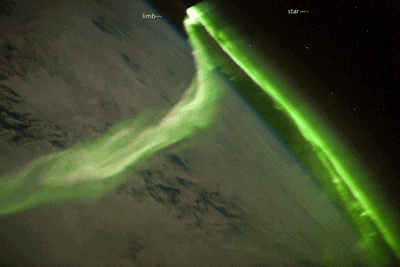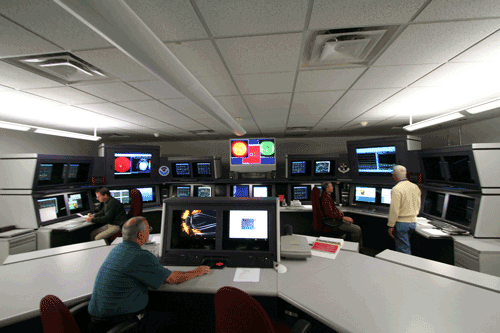Our planet is experiencing one at the moment, but what is it?
Right now, the Earth is being bombarded by a storm of charged particles from the Sun, a direct result of two solar flares having erupted on its surface this past week.

Image of flare shows that the entire surface of the sun seems to ripple with the force of the eruption. These waves travel, approximately speaking, at one millions miles per hour.
One of the flares was categorized as an X5.4, making it the second largest of its kind since the sun entered a period of low activity in early 2007 (an X6.9 was recorded on August 9, 2011). That, combined with the second, not-as-large flare has subjected Earth to a solar storm that is the largest of its kind in more than five years.
The two flares are traveling separate from one another, with the first one moving more than 1,300 miles per second, while the second is speeding along at more than 1,100 miles per second. NASA predicts that beyond impacting Earth, the effects of these flares will also be felt on Mars, as well as several NASA spacecraft, including Messenger, Spitzer, and STEREO-B.
Need a refresher on this subject? Here’s a crash course on five key points about solar flares, cycles, and storms:
Solar cycles
The Sun goes through phases of high and low activity every 11 years or so. The variation in cycles is marked by the number of dark spots, or “sunspots”, on the Sun. As the number of these spots increase, so does solar activity.
Sunspots are the source of solar flares, which are considered the most violent events in the solar system. In a short matter of time (minutes) a large flare is capable of releasing a million times more energy than the largest earthquake.
A closer look at solar flares
A solar flare, by definition, is a burst of radiation that comes from the release of the magnetic energy associated with sunspots. They can also be classified as the sites where particles (electrons, protons, or heavier particles) are accelerated.
Solar flares can be seen by the photons that they release: on the sun’s surface, they are brighter than the rest of the surrounding area. A solar flare can last anywhere from a few minutes to several hours.
What about CMEs?
The corona is the outer solar atmosphere; it’s structured by strong magnetic fields. When these fields are closed above sunspot groups, the confined solar atmosphere reacts violently by releasing bubbles of gas and magnetic fields called coronal mass ejections (CME).
Larger CMEs contain about a billion tons of matter, and can be accelerated to travel at speeds of several million miles per hour when part of a spectacular explosion. This speedy solar material streams out through the interplanetary medium, and will impact any planet or spacecraft in its path.
How do solar flares and CMEs affect Earth?
A solar flare is made up of photons and will travel in a straight trajectory from its original site. That means that when a solar flare occurs on the side of the sun facing Earth, it impacts our planet.
As far as CMEs go, they’re large clouds of plasma and magnetic field that erupt from the sun; they can go in any direction. Once released though, they continue in that same direction, plowing through anything that’s in its way. So, only when a CME is directed at Earth will it actually hit us.
When the Earth is impacted by these events, solar particles and magnetic fields are, essentially, dumped into the Earth’s atmosphere. Depending on the amount of particles, this “dumping”, if you will, can distort the planet’s magnetic fields and cause a geomagnetic storm.
For reference, what the Earth is experiencing right now is a G2-rated geomagnetic storm (on a scale from G1 to G5).
When storms are this big, it affects the Earth’s surface which, in turn, affects our technology. Gadgets, gizmos and other technologically-based items that can be disrupted by a geomagnetic storm include:
• Satellites
• GPS devices
• Space shuttle and space station activities
• High-altitude polar flights
• Electric power distribution
• Long-line telephone communication
• HF radio communication
• Pipeline operations
• Geophysical exploration
These events also impact the Earth’s aurora, better known as the solar lights. If you’re unfamiliar with them, they are, in layman’s terms, the visible effects of solar activity within the Earth’s atmosphere.

The Southern Lights, as observed from the International Space Station.
Solar lights are a result of solar wind, or the continuous flow of the electrically charged particles coming in from the sun. When these particles reach the earth’s magnetic field, some become trapped and travel toward the Earth’s magnetic poles. Along the way, these charged particles strike atoms and molecules in the atmosphere. This results in energy being released, which appears in the form of the auroras.
Most solar light displays occur 50 to 200 miles above the Earth’s surface, with some extending lengthwise across the sky for thousands of miles. The most common color is green, but displays that occur extremely high in the sky have shown up as red or purple. Auroral displays that occur in the Northern Hemisphere are called the “aurora borealis”, or “northern lights,” while those in the Southern Hemisphere are called the “aurora australis”.
Auroras occur most frequently during solar maximum. That’s because the electrons and protons released by the solar storms add to the number of solar particles interacting with the Earth’s atmosphere, thus increasing particle interaction and producing extremely bright auroras.
With the current storm, it is expected that the auroras will not only be brighter, but they’ll also be seen further down in latitude from the Earth’s poles, making them visible in parts of the world where they’re normally not seen.
Who’s out there monitoring all of this activity?
If you like acronyms, then you’ll really like this section.
The National Oceanic and Atmospheric Administration’s (NOAA) Space Weather Prediction Center (SWPC) is the country’s official source of space weather alerts, watches and warnings. They monitor and forecast all solar and geophysical events.
SWPC is part of the National Weather Service (NWS) and is one of the nine National Centers for Environmental Prediction (NCEP). More specifically, it is SWPC’s Space Weather Operations branch (SWO) that is the national and world warning center for disturbances that can affect people and equipment working in the space environment. Jointly operated by NOAA and the U.S. Air Force, the SWO is the group that provides forecasts and warnings of solar and geomagnetic activity to users in the government, industry, and the private sector.
The team here continuously monitors, analyzes, and forecasts the environment between the Sun and Earth. They collect solar and geophysical data in real time from ground-based observatories and satellite sensors around the world, which forecasters use to predict solar and geomagnetic activity.
When necessary, they issue worldwide alerts of extreme events (like the one we’re experiencing now).

Forecast center in NOAA’s Space Weather Prediction Center in Boulder, CO.
Reference
All information and photos were used from NASA’s website. ■
Advertisement
Learn more about Electronic Products Magazine





